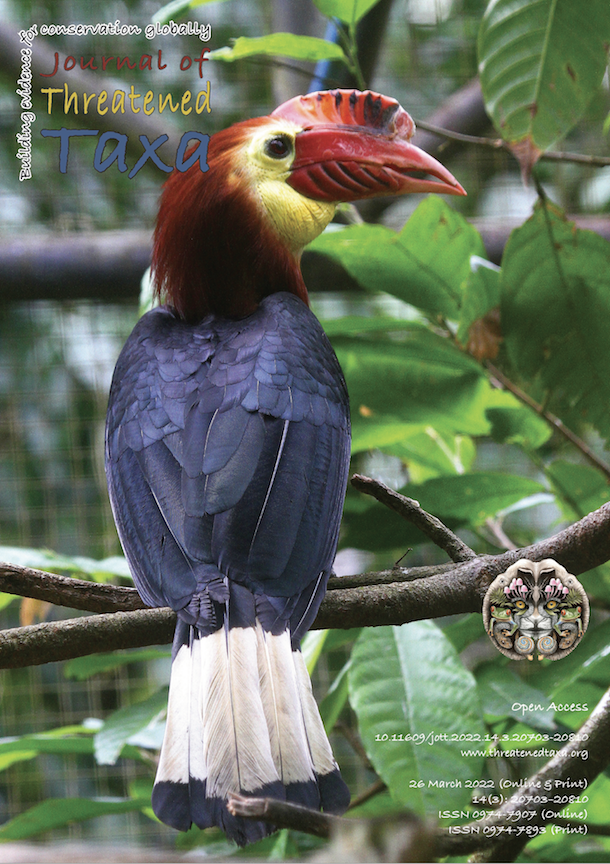Habitat preference and population density of threatened Visayan hornbills Penelopides panini and Rhabdotorrhinus waldeni in the Philippines
Main Article Content
Abstract
The habitat preference and population density of the Critically Endangered Rufous-headed Hornbill Rhabdotorrhinus waldeni and Endangered Visayan Tarictic Hornbill Penelopides panini were studied in the Central Panay Mountain range in Panay Island, western Visayas. Point counts were established to survey for hornbills and habitat variables were measured in a 30 x 30 m plot at each point. P. panini was recorded in primary and secondary forest, while records of R. waldeni were mostly in primary forest, with only one record in secondary forest. Spearman’s rank order correlation and stepwise multiple regression showed that R. waldeni is positively correlated to density of large trees (>70cm DBH), with the Visayan Tarictic Hornbill showing moderate correlation with density of medium-sized trees (31–70 cm DBH). Central Panay Mountains is the largest remaining forests block in western Visayas. It is the stronghold area of R. waldeni and other western Visayas threatened species, supporting the need to declare the site a protected area.
Article Details

This work is licensed under a Creative Commons Attribution 4.0 International License.
Authors own the copyright to the articles published in JoTT. This is indicated explicitly in each publication. The authors grant permission to the publisher Wildlife Information Liaison Development (WILD) Society to publish the article in the Journal of Threatened Taxa. The authors recognize WILD as the original publisher, and to sell hard copies of the Journal and article to any buyer. JoTT is registered under the Creative Commons Attribution 4.0 International License (CC BY), which allows authors to retain copyright ownership. Under this license the authors allow anyone to download, cite, use the data, modify, reprint, copy and distribute provided the authors and source of publication are credited through appropriate citations (e.g., Son et al. (2016). Bats (Mammalia: Chiroptera) of the southeastern Truong Son Mountains, Quang Ngai Province, Vietnam. Journal of Threatened Taxa 8(7): 8953–8969. https://doi.org/10.11609/jott.2785.8.7.8953-8969). Users of the data do not require specific permission from the authors or the publisher.
References
BirdLife International (2021). Species factsheet: Penelopides panini. Available from http://www.birdlife.org. Accessed on February 26, 2016.
BirdLife International (2021). Species factsheet: Rhabdotorrhinus waldeni. Available from http://birdlife.org. Accessed on February 26, 2016.
BirdLife International (2022). Species factsheet: Rhabdotorrhinus waldeni. Available from http://birdlife.org. Accessed on http://www.birdlife.org on 25/03/2022.
Collar, N.J., N.A.D. Mallari & B.R.J. Tabaranza (1999). Threatened birds of the Philippines: the Haribon Foundation/ BirdLife International Red Data Book. Bookmark, Makati City.
Condeno, R. (2018). Biodiversity Change in the Panay Mountain Range 2014–2017. Forest and Climate Protection in Panay - Phase II. Deutsche Gesellschaft für Internationale Zusammenarbeit (GIZ). Dilliman, Quezon City.
Curio, E., M. Kauth, S.L. Engel & L.L. Lastimoza (1998). Observations on the Breeding Biology of the Writhed-billed Hornbill (Aceros waldeni) in the Philippines. Journal of Ornithology 139: 475–483.
de Alban, J.D., R. Condeno, M. Gonzales, N. Resureccion & J. Jalbuena (2004). Sibalom Natural park, Antique: Integrating Forest Conservation with Local Governance: Technical Report. Haribon Foundation Inc.
Department of Environment and Natural Resources – Forest Management Bureau (2013). Philippine Forest Facts and Figures. DENR – FMB. Quezon City, Philippines.
Department of Environment and Natural Resources – Forest Management Bureau (2017). Philippine Forest at a Glance. Forest Policy, Planning and Knowledge Management Division, FMB. Diliman, Quezon City.
Gonzalez, J.C., B. Sheldon, N.J Collar & J. Tobias (2013). A comprehensive molecular phylogeny for the hornbills (Aves: Bucerotidae). Molecular Phylogenetics and Evolution 67(2): 468–483. https://doi.org/10.1016/j.ympev.2013.02.012
Kemp, A. (1995). The Hornbills: Bucerotiformes. Oxford University Press Inc., New York, x+302 pp.
Kemp, A.C. (2001). Family Bucerotidae (Hornbills), pp. 436–523. In: del Hoyo, J., A. Elliott & J. Sargatal (eds.). Handbook of the Birds of the World - 3. Lynx Edicions, Barcelona, Spain.
Kennedy, K.S., P.C. Gonzales, E.C. Dickinson, H.C.J. Miranda & T.H. Fisher (2001). A Guide to the Birds in the Philippines. Oxford University Press, New York, 540pp+72 color plates.
Kinnaird, M.F. & T.G. O’Brien (2007). The Ecology and Conservation of Asian Hornbills; Farmers of the Forest. Chicago. University of Chicago Press.
Klop, E., E. Curio & L. Lastimoza (2000). Breeding Biology, Nest Site Characteristics and Nest Spacing of the Visayan Tarictic Hornbill Penelopides panini panini on Panay, Philippines. Bird Conservation International 10: 17–27.
Mynott, H.I., D.C. Lee, R.A. Santillan, C.J. Schwarz, B. Tacud, A.D. Fernandez & D. Kerhoas (2021). Population assessment and habitat associations of the Visayan Hornbill (Penelopides panini) in Northwest Panay, Philippines. Avian Research (2021) 12: 67.
National Mapping and Resource Information Authority (2010). Department of Environment and Natural Resources. Taguig City.
Negros Island Biodiversity Strategy and Action Plan (2018). DENR- BMB and Philippines Biodiversity Conservation Foundation Inc., Bacolod City.
Paguntalan, L.M.J., J.C.T. Gonzalez, M.J.C. Gadiana, A.T.L. Dans, M.dG. Pedregosa, A. Cariño & C.N. Dolino (2002). Birds of Ban-Ban, Central Negros, Philippines: threats and conservation status. Silliman Journal 43(1): 110–136.
Paguntalan, L.M.J., P.G.C. Jakosalem, M. dG. Pedregosa, M.J.G. Catacutan & R. Bueno (2004). Conservation Status of Forest Birds in Isolated Forest R. Patches in Masbate, Philippines. Silliman Journal 45(2): 222–236.
Philippines Biodiversity Conservation Foundation and Biodiversity Management Bureau (2018). Negros Island Biodiversity Strategy and Action Plan. Impress Printing Press, Bacolod, 64 pp.
Poonswad, P. (1991). Hornbill, pp. 63–73. In: Insight Guide: Southeast Asia Wildlife. APA publication (HK) Ltd., 430 pp.
Quimpo, J.D.G., B.R.J. Tabaranza, R.C. Martinez, G. Azarez, N.A. Resurrecion, A.A. Alabado, J. Espiritu, J.K. Panopio, K.C. Artiaga & M.C. Bueno (2014). Central Panay Mountain Ranges (CPMR). Panay Island Biophysical survey technical report for Cluster 1 municipalities (Pandan, Sebaste, Culasi, and Tibiao). ForClim Project 2010–2014.
Raman, T.R.S. & D. Mudappa (2003). Correlates of hornbill distribution and abundance in rainforest fragments in the Southern Western Ghats, India. Bird Conservation International 13: 199–212.
Schade, J. (2018). Forest Cover and Carbon Monitoring in the Panay Mountain Range. Manila Philippines. Deutsche Gesselschaft für Internationale Zusammenarbeit (GIZ). Technical Report.

